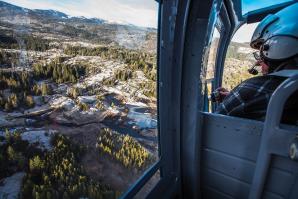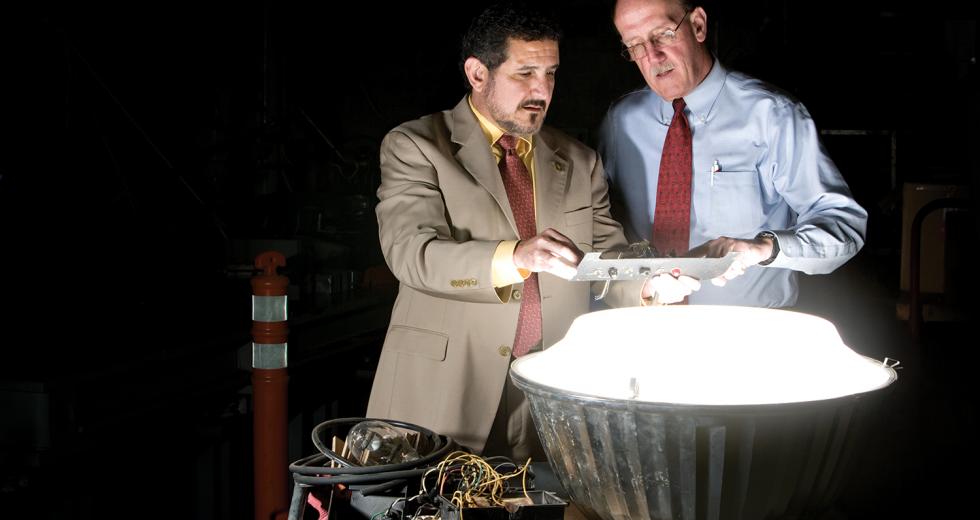Customers of the Sacramento Municipal Utility District and other power providers could soon realize the benefits of living on a smarter grid. Smart grids use digital technology to monitor the flow of power between suppliers and users to improve efficiency and reliability, and Sacramento is attempting to lead the way with this technology.
The technology’s potential in the Capital Region is so strong, in fact, that 67 percent of the federal stimulus funding awarded for smart grids in California came to the Capital Region, according to Emir Macari, dean of the College of Engineering and Computer Science at Sacramento State.
Now SMUD and its local partners — Sacramento State, the California Department of General Services and the Los Rios Community College District — are using $127.5 million in federal grant funding to research, troubleshoot and install a regional smart grid system.
“Our grid has not changed in 80 years,” Macari says. “The problem with the existing infrastructure is that transmitting electricity long distances results in leakage. And it’s only a one-way valve. A house cannot generate energy and put it back into the system.”
For that reason among many others, the California Smart Grid Center at Sacramento State was created in 2008. Students and faculty at the center work directly with local, state and national utilities to support sustainable updates to the nation’s electric grid, and they also test up-and-coming technologies that have not yet gone to market. The center is undertaking six research projects, five of which are funded by roughly $1 million from the California Energy Commission.
“We want to be known as a sustainable campus and for students to revel around this idea,” Macari says. “We formed this great partnership and a new vision for a smart Sacramento, and [Sacramento] State will become the first smart grid campus in America.”
When completed in 2012, SMUD’s smart grid would enable customer participation as well as improve the reliability and efficiency of utility operations.
SMUD and its local partners are using $127.5 million in federal grant funding to research, troubleshoot and install a regional smart grid system.
SMUD’s smart grid, which Sacramento State is helping to develop, would include more than 600,000 smart meters, 100 electric vehicle charging stations and 50,000 residential energy control systems, including programmable smart thermostats.
“We are interested in doing something meaningful,” Macari says. “In our small way we can contribute something to the national energy shortage.”
With such opportunities for growth, technology development and funding, the California Smart Grid Center has become the link to business development in the Power Inn region.
“The California Smart Grid Center offers independent, unbiased field testing of new technologies by a state-sanctioned applied research center,” says J.D. Stack, the center’s new administrator. “One recent test of a wireless thermostat system by Cypress Envirosystems, which had favorable results, was widely reported in the technology media. Local businesses can similarly leverage new business opportunities off Sacramento State’s statewide and national leadership in smart grid technology.”
City planners, medical technology companies and clean-tech companies have been collaborating on a new research and development park south of Highway 50 called Granite Regional Park. The Power Inn Alliance, a group of more than 600 business and property owners, are spawning a sort of green-tech village there comprised of housing, light-rail and, of course, lots of well-paid jobs focused on the smart grid, biomedical research and other innovative technologies.
“We want to be known as a sustainable campus and for students to revel around this idea.”
Emir Macari, dean of the College of Engineering and Computer Science, Sacramento State
“It takes a village to raise a startup, and that’s what we’re doing here,” Stack says.
Meanwhile, as a result of downsizing, the city of Sacramento has put plans for its Innovation/Technology Village on hold at least until the end of the year. The village would encompass the area from Folsom Boulevard south to 14th Street and from Power Inn Road west to the railroad tracks and, like Granite Park, is intended to attract and serve innovative and technology companies in an area now comprised primarily of recycling and land fill operations.
Together, the Power Inn Alliance and Sacramento State are making an effort to direct incoming medical technology and clean energy research and development toward the park, eventually creating a seamless technology corridor stretching from Power Inn to the UC Davis Medical Center.
“[Sacramento] State works closely with [the Sacramento Area Regional Technology Alliance] and its CleanStart and MedStart initiatives to make university resources -— faculty, students and labs — available to clean-tech and med-tech companies,” Stack says.
For example, two teams of mechanical engineering students are working with Solera Power Corp. on Power Inn Road to refine its solar thermal system design. Sacramento State is also pledging campus resources toward a new grant proposal to create the Medical Device Design and Innovation Center in this corridor.
“When your hard work provides results and when you bring extra value to the community, that’s what a state university is all about, “ Macari says. “[Sacramento] State is ready.”
Did you know
…
the Sacramento Natural Gas Storage proposal calls for storing gas in a sandstone formation three-quarters of a mile below the ground? An environmental impact report by the California Public Utilities Commission confirms the safety of the project southwest of Depot Park. The next steps are final review by the California Public Utilities Commission later this year and city approvals early in 2011. Injecting natural gas into the existing chamber would increase energy reliability for the Sacramento Municipal Utility District and other users. The compressor station site will be located in Depot Park, and construction of underground pipelines will take place in an existing utility right-of-way.
Recommended For You
Power Forward
A Brighton spot for Power Inn’s future
In the late 1800s the township of Brighton, along what is now Folsom Boulevard and Power Inn Road, was bustling with a racetrack, pony express stop and the distinguished (if unrecognized) title of Sacramento’s first suburb.

Keeping the Lights On
Behind the scenes with the Sacramento Municipal Utility District
A backstage look at how the crew at SMUD keeps Sacramento lit up.



